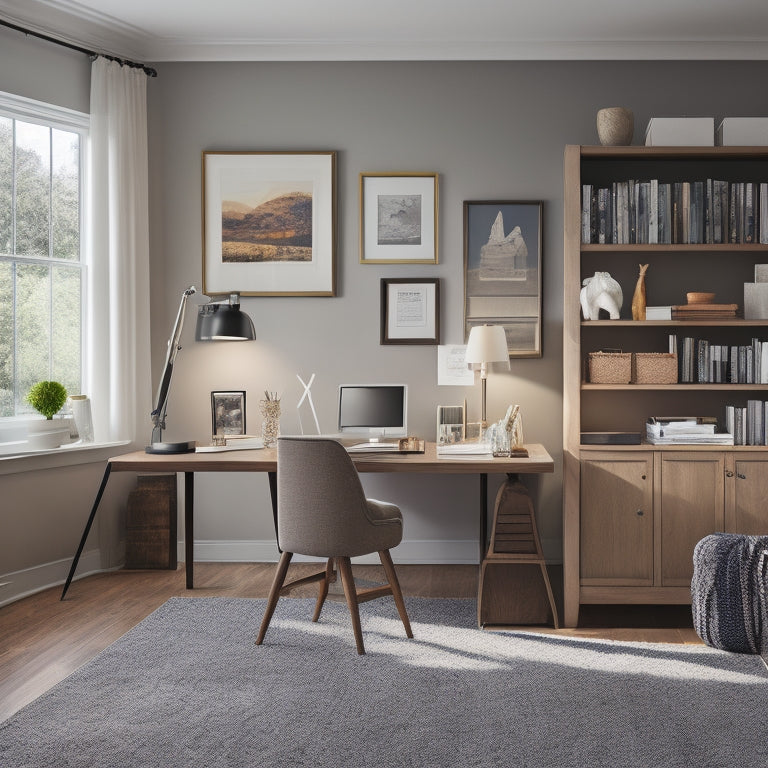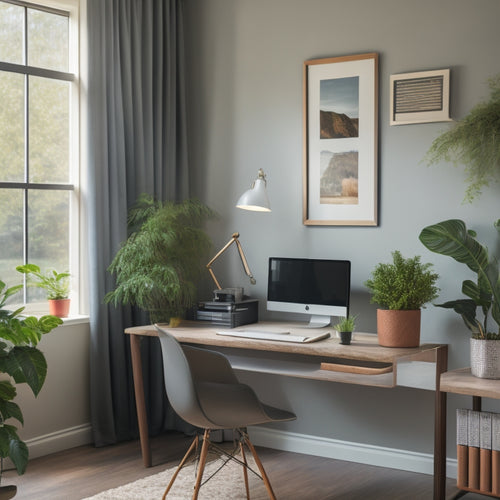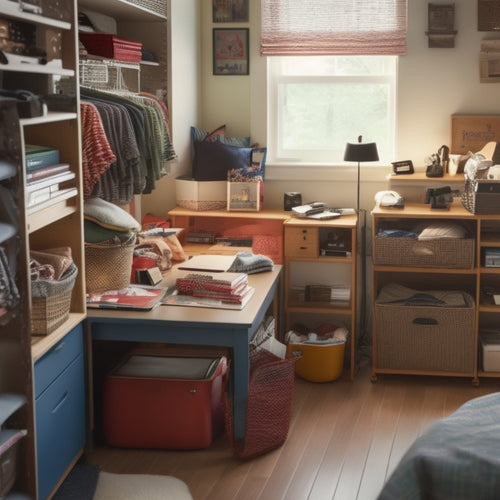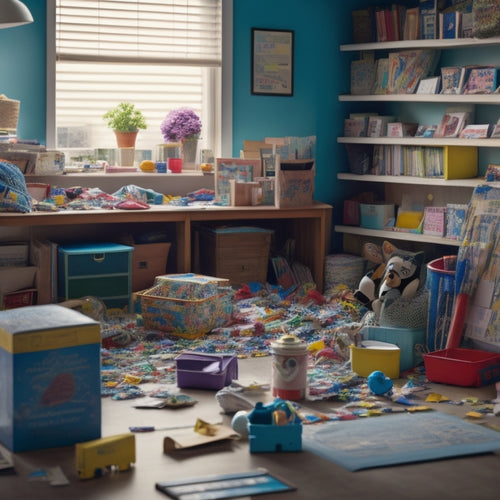
Simplify Your Space: Senior-Friendly Home Office Organization
Share
To simplify your space, start by decluttering your home office and sorting items into categories. Adopt a minimalist decor approach and organize your digital files in cloud-based storage. Invest in senior-friendly essentials like easy accessibility tools, simple storage solutions, and ergonomic workspace essentials. Designate a specific workspace area, invest in ergonomic seating and proper lighting, and create a functional layout for efficiency. Use clear category labels, visible file names, and easy-to-read signs with color coding and large font sizes. By implementing these strategies, you'll be well on your way to creating a comfortable, organized space that enhances your productivity - and there's even more to explore.
Key Takeaways
• Designate a specific workspace area and invest in ergonomic seating and proper lighting for comfort and efficiency.
• Adopt a minimalist decor approach and use clear category labels and visible file names for easy navigation.
• Centralize technology with a tech hub for devices and accessories, and use user-friendly software for digital file management.
• Implement storage solutions for small spaces, such as maximizing storage capacity with space-saving furniture and labeled bins.
• Establish a regular maintenance routine to tidy up, update digital systems, and back up documents to ensure ongoing organization.
Decluttering Your Home Office Space
Decluttering Your Home Office Space
Start by clearing everything out of your home office space. Sort items into categories like 'keep,' 'donate,' and 'recycle' to get a sense of what you're working with and what you can eliminate. This step is vital in creating a senior-friendly home office that's functional and efficient.
As you sort, consider adopting a minimalist decor approach. This will help reduce visual clutter and create a more peaceful workspace.
Next, take inventory of your digital files and organize them in a way that makes sense to you. Consider digitizing paper documents and storing them in cloud-based storage services, like Google Drive or Dropbox. This will free up physical space and make it easier to access important documents from anywhere.
By implementing digital organization systems, you'll be able to quickly find the information you need, reducing stress and increasing productivity.
Essential Items for Seniors Only
Now that you've decluttered your home office, it's time to focus on the essential items that'll make your workspace senior-friendly.
You'll want to prioritize tools that promote easy accessibility, simple storage solutions that keep your essentials within reach, and ergonomic workspace essentials that reduce strain on your body.
Easy Accessibility Tools
You'll want to integrate user-friendly accessibility tools into your home office setup to make sure you can work comfortably and efficiently. As a senior, prioritizing your comfort and safety while working from home is crucial. Senior-friendly tech gadgets, like keyboards with large buttons and monitors with high contrast, can greatly enhance your overall experience.
Organizing tools such as adjustable desk organizers and file holders can also assist you in staying focused and avoiding clutter.
When designing your accessible workspace, consider ergonomic solutions that meet your needs. For example, a cozy, adaptable chair can reduce strain on your back and neck, while a document holder can help prevent eye strain. It's essential that your workspace is well-lit and free from obstacles to prevent accidents.
Simple Storage Solutions
As a senior, designating specific storage spots for essential items, such as reading glasses, magnifying glasses, and important documents, helps maintain a clutter-free workspace and reduces time wasted searching for misplaced items. This is especially important for frequently used items, which should be easily accessible to save time and energy.
Consider investing in functional shelving units that are designed to maximize storage capacity while minimizing floor space. Look for shelves with adjustable heights and removable baskets to customize your storage needs.
You can also utilize space saving solutions like wall-mounted organizers or compact file cabinets to keep important documents within reach.
Ergonomic Workspace Essentials
To create a comfortable and functional home office, invest in ergonomic workspace essentials specifically designed for seniors. This includes adjustable chairs, ergonomic keyboards, and document holders that reduce strain on your eyes, neck, and hands. These items will help you work efficiently without compromising your physical comfort.
Consider incorporating standing desks or adjustable chairs that allow you to switch between sitting and standing throughout the day. This can help reduce back pain and improve circulation.
Additionally, invest in monitor risers and keyboard trays to optimize your screen and typing position. This will prevent you from hunching over or straining your neck and wrists.
Simplify Your Workspace Layout
Clear the clutter by designating a specific area for your workspace, allowing you to focus on the task at hand. This dedicated space will help you stay organized and productive.
Invest in ergonomic seating options that provide comfort and support, ensuring you can work for extended periods without straining your back or joints. Proper workspace lighting is also pivotal, so consider installing task lamps or overhead lighting that reduces eye strain.
Next, create a functional layout that promotes efficiency. A minimalist desk decor approach will help you avoid distractions and keep your mind on the task. Remove any unnecessary items and keep only the essentials within easy reach.
Consider a desk with built-in storage or a nearby shelving unit to keep frequently used items organized and out of the way. By streamlining your workspace layout, you'll be able to work more efficiently and effectively, achieving your goals with greater ease.
Labeling and Signage Strategies
As you set up your home office, you'll want to make sure everything is easy to find and access. To achieve this, you'll need a labeling and signage strategy that works for you.
Clear Category Labels
You'll discover the importance of assigning distinct labels to each category of items in your home office, ensuring you can quickly identify where everything belongs. This is especially vital for seniors, as clear labels can help reduce confusion and frustration.
To get started, sort your items into categories, such as 'office supplies,' 'important documents,' and 'mail.' Then, assign a unique label to each category, using a font size and style that's easy to read.
Consider using color coding to differentiate between categories. For example, you could use red labels for important documents and blue labels for office supplies. You can also use size labeling to indicate the priority or urgency of an item. For instance, larger labels could be used for time-sensitive documents, while smaller labels could be used for less important items.
Visible File Names
Assign file names that accurately mirror their contents, making it simple to identify what's inside without having to open the file. This straightforward step will save you time and reduce frustration when searching for specific documents.
When creating file names, use clear and descriptive language, avoiding abbreviations and acronyms that might be confusing.
To elevate your file organization, consider using color-coded labels and digital organization tools. This will allow you to categorize your files into distinct groups, making it simple to locate specific documents.
For example, you can use different colors to label files related to taxes, insurance, or personal documents. Digital organization tools, such as folders and tags, can also help you maintain your files organized and easily accessible.
Remember to use large font and clear categories when creating your file names. This will make certain that you can quickly read and understand the contents of each file, even if your eyesight isn't what it used to be.
Easy-to-Read Signs
Create clear and concise labels for your file folders and storage bins, using large font sizes and high-contrast colors to guarantee easy readability. This will help you quickly identify what's inside without straining your eyes. Consider using a label maker or writing the labels by hand with a thick marker.
To take your labeling to the next level, try color coding your labels to categorize different types of files or storage bins. For example, you could use red for important documents, green for financial records, and blue for personal papers.
Here are some tips for creating effective labels:
| Label Type | Font Size | Color Scheme |
|---|---|---|
| File Folders | 24-36 pt | Black on White or White on Black |
| Storage Bins | 36-48 pt | Bright Colors (e.g. Red, Green, Blue) |
| Shelves | 48-60 pt | Contrasting Colors (e.g. Black on Yellow) |
| Desk Drawers | 24-36 pt | Pastel Colors (e.g. Light Blue, Pink) |
Ergonomic Furniture for Comfort
Invest in an ergonomic chair with adjustable lumbar support and armrests to reduce strain on your back and shoulders while working from home. A comfortable design with adjustable features will allow you to customize the fit to your body, promoting good posture and reducing discomfort. This is especially important for seniors, who may experience back or joint pain.
When selecting a chair, look for supportive seating that encourages proper alignment. A chair with a breathable fabric or mesh and a waterfall edge (a curved edge that reduces pressure on your legs) will keep you cool and comfortable during long work sessions.
Consider a chair with a recline function, which can help you shift positions and reduce fatigue. By investing in an ergonomic chair, you'll be able to work comfortably and efficiently, without sacrificing your physical well-being.
Technology Organization Made Easy
You'll streamline your work process by corralling your devices, cords, and accessories into a centralized tech hub, keeping everything within easy reach. This tech gadget organization will simplify your digital life, reducing frustration and increasing productivity. Invest in a user-friendly software that helps you manage your digital files, making it easy to find what you need when you need it.
Next, tackle cable management by using cord organizers or cable ties to keep your workspace clutter-free. This will prevent tangles, reduce eye strain, and make it easier to move around your workspace.
Digital clutter control is also essential. Set aside time to organize your computer files, deleting unnecessary documents and categorizing the rest. Consider implementing a 'one touch rule' where you deal with digital tasks as soon as you receive them, reducing the likelihood of digital clutter building up in the future.
Creating a Maintenance Routine
Regularly scheduling time to maintain your newly organized space will safeguard it stays clutter-free and functional. Set aside a specific time each week, whether it's 30 minutes or an hour, to maintain your space. This could be as simple as tidying up your desk, filing away papers, or updating your digital organization systems.
Effective time management is crucial to maintaining your organized space. You can use a planner, calendar, or app to schedule your maintenance sessions and set reminders. This will guarantee you stay on track and don't let clutter build up again.
In addition to physical maintenance, don't forget to update your digital organization systems regularly. This includes organizing your computer files, updating your password manager, and backing up your important documents. By incorporating digital organization into your maintenance routine, you'll stay on top of your digital clutter and safeguard your online life remains organized and stress-free.
Storage Solutions for Small Spaces
In small home offices, every square inch counts. Maximizing storage capacity is essential with clever solutions that keep frequently used items within easy reach. You'll want to invest in space-saving furniture that serves multiple purposes, such as a compact desk with built-in shelving or a filing cabinet with a small footprint.
Consider vertical storage solutions that make the most of your ceiling height, like wall-mounted shelves or storage units that can be easily accessed with a step stool. This will help keep your workspace clutter-free and organized.
When choosing storage solutions, think about the items you use most frequently and prioritize those. Keep essential office supplies, like paper and pens, in easy-to-reach locations, while less frequently used items can be stored away in labeled bins or baskets.
Adapting to Changing Needs
As your work style and tasks evolve, your home office organization system must adapt to accommodate new priorities and tools. You may find that you need to make changes to your workspace to ensure comfort and accessibility.
Consider incorporating mobility aids, such as a walker or wheelchair, to guarantee easy navigation around your office. Invest in an ergonomic chair that provides proper support for your back and neck.
As you age, you may experience changes in your vision, so it's vital to have adjustable lighting solutions that cater to your needs. Consider installing task lighting, such as under-cabinet lights or desk lamps, to provide focused illumination where you need it most.
Adjustable desks can also be beneficial, allowing you to switch between sitting and standing throughout the day. By making these adaptations, you'll be able to maintain your productivity and independence while working from home.
Frequently Asked Questions
How Do I Handle Sentimental Items I Don't Need but Can't Discard?
When decluttering sentimental items, you're torn between emotional attachment and minimalism. Acknowledge the memories, take a photo, and let go; or repurpose the item into something new, allowing you to keep the memory, not the clutter.
Can I Still Use My Old Furniture or Should I Replace It Entirely?
You can still use your old furniture if it's functional and comfortable, or consider upcycling/repurposing it to fit your new space. Assess compatibility with new furniture options to create a cohesive look.
What if I Have Limited Mobility to Organize My Space Myself?
If you have limited mobility, consider hiring professional assistance to organize your space or explore accessible tools that can aid you in the process, and prioritize adaptive solutions and an ergonomic setup that cater to your needs.
Are There Any Specific Home Office Organization Apps for Seniors?
"Oh, you're finally embracing technology, huh? Well, you're in luck! There are senior-friendly home office organization apps designed specifically for you, featuring accessibility features, user-friendly interfaces, and technology solutions that cater to your needs."
How Often Should I Review and Update My Home Office Organization System?
You should regularly review and update your home office organization system every 3-6 months to maintain its effectiveness, ensuring it still meets your needs and adapting to changes in your work habits and priorities.
Related Posts
-

Master Your Space With Digital Decluttering Tools
You're tired of feeling overwhelmed by digital clutter, wasting time searching for lost files, and struggling to focu...
-

Why College Students Need Smart Storage Systems
As you navigate the challenges of college life, you'll quickly realize that a smart storage system is essential to tr...
-

What's the Best Home Organization System for ADHD?
You need a home organization system that acknowledges your unique brain chemistry and works with your ADHD, not again...


